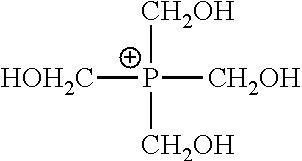Flame resistant textile materials providing protection from near infrared radiation
a textile material and near infrared technology, applied in the field of textile material treatment, can solve the problems of shock wave, garments that are uncomfortable, and heat from electric arc flash can be extremely intens
- Summary
- Abstract
- Description
- Claims
- Application Information
AI Technical Summary
Benefits of technology
Problems solved by technology
Method used
Image
Examples
Embodiment Construction
[0009]As noted above, the invention provides flame resistant textile materials. As utilized herein, the term “flame resistant” refers to a material that burns slowly or is self-extinguishing after removal of an external source of ignition. The flame resistance of textile materials can be measured by any suitable test method, such as those described in National Fire Protection Association (NFPA) 701 entitled “Standard Methods of Fire Tests for Flame Propagation of Textiles and Films,” ASTM D6413 entitled “Standard Test Method for Flame Resistance of Textiles (vertical test)”, NFPA 2112 entitled “Standard on Flame Resistant Garments for Protection of Industrial Personnel Against Flash Fire”, ASTM F1506 entitled “The Standard Performance Specification for Flame Resistant Textile Materials for Wearing Apparel for Use by Electrical Workers Exposed to Momentary Electric Arc and Related Thermal Hazards”, and ASTM F1930 entitled “Standard Test Method for Evaluation of Flame Resistant Clothi...
PUM
| Property | Measurement | Unit |
|---|---|---|
| wavelengths | aaaaa | aaaaa |
| reflectance | aaaaa | aaaaa |
| wavelengths | aaaaa | aaaaa |
Abstract
Description
Claims
Application Information
 Login to View More
Login to View More - R&D
- Intellectual Property
- Life Sciences
- Materials
- Tech Scout
- Unparalleled Data Quality
- Higher Quality Content
- 60% Fewer Hallucinations
Browse by: Latest US Patents, China's latest patents, Technical Efficacy Thesaurus, Application Domain, Technology Topic, Popular Technical Reports.
© 2025 PatSnap. All rights reserved.Legal|Privacy policy|Modern Slavery Act Transparency Statement|Sitemap|About US| Contact US: help@patsnap.com


